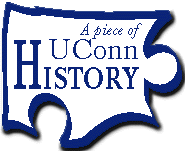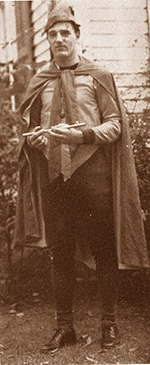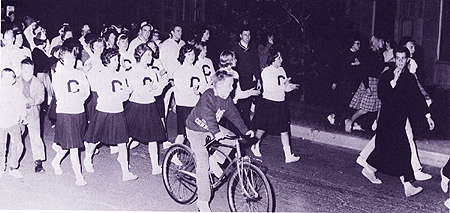This is an archived article. For the latest news, go to the Advance Homepage.
For more archives, go to the Advance Archive/Search Page. 
| ||||||||
Part one of this series on UConn traditions, in the September 6 issue, focused on the Freshmen Banquet, an oftentimes violent confrontation in which freshmen had to hold a banquet and sophomores had to prevent it from happening.
"It was replaced by the Pig Roast, a slightly more sophisticated form of freshman hazing that took the rioting away from cities and out of public restaurants and inns, and concentrated it in the rural fields and woods of Mansfield," wrote Evan Hill in an unpublished manuscript written for the University's centennial in 1981.
The rules of the Pig Roast called upon the freshmen (and they were men only - women were prohibited from participating) had to roast a pig weighing at least 50 pounds over a wood fire for at least one hour in the open air. The class president and 50 percent of the class membership had to be present for the event. A revised rule later said that if the president was not present for the Pig Roast, 70 percent of the class had to attend. Using automobiles during the allotted time was prohibited, as was constraining any freshman for more than five hours. Stripping prisoners of their clothing was banned, too. The use of weapons was also forbidden. On December 12, 1923, at noon - 12 hours before that year's roast was to begin - students were in an assembly at the Main Building when freshmen were ordered to Gulley Hall. They piled on to flatbed trucks that had just pulled up and, before the sophomores knew what was happening, the freshmen were off to hide at a dance hall in Webster, Mass. "But as the afternoon wore on, some of the bored freshmen ventured out on the street where some cruising sophomores promptly spotted them," said Hill. There was a near-riot, as reported by the Webster Times the next day, but the freshmen regrouped and went back into their hideout, which went undiscovered. They snuck back to Mansfield and held their pig roast that night near the Fenton River at Mount Hope. With autos banned, they trudged back to campus and were immediately confronted by belligerent sophomores, who "were appalled to learn that the pig had already been roasted," wrote Hill. Hazing of freshmen came to an end in 1925 when President Charles Beach abolished all forms of the activity because of a serious spinal injury to a freshman who had been paddled. That order brought an end to an event known as the Pajama Parade. In that short-lived activity, new men, wearing only their pajamas, had to gather in front of their dormitories and march through campus singing "How Green We Are," as they were paddled by sophomores. In 1932, with the Pajama Parade long gone, as well as the Horse and Cannon Rushes, the Pig Roast was replaced with a more light-hearted event - although there was still some hazing involved - which would last for 40 years as a campus tradition. President Charles McCracken decided there should be a substitute for the Pig Roast, and he asked Herbert France, the new director of the music program, to come up with an idea. "Mr. France, who seems like a very peppy kind of person, instituted a new proceeding tonight," wrote Edwina Whitney in her diary entry for September 23, 1932. Whitney was the college librarian from 1900 to 1934. "He led the band around to all the dormitories and collected the students, who followed to benches which had been put up back of Beach Hall. The freshmen boys wore their gayest pajamas and the girls gym suits, etc. A very colorful sight when all were assembled. Singing in chorus and some solo, with some humorous talks, filled an hour or so. Then I went home but the others to a big bonfire between the dorms," wrote Whitney. This was the pattern for the next four decades of what was called the Pied Piper Parade. For the first parade during Freshmen Week in 1932, France dressed the president of the Student Organization (the 1932 equivalent of today's Undergraduate Student Government) in a costume like that of the legendary Pied Piper of Hamelin. The Piper led the 35-member band through the campus, first to the home of President and Mrs. McCracken, who fell in behind the band, and then on to the women's and men's residence halls. The halls emptied, and even townspeople joined in the parade that marched to Beach Hall. The first parade drew 1,500 marchers, at a time when total enrollment was only 706 students. At bleachers set up outside Beach Hall, participants heard the Men's Glee Club and soloists sing, and there were humorous skits and speeches. Over the years, the event changed, to include an annual mock election for "The Mayor of Storrs," and later a candle-light ceremony, with each freshman lighting his or her candle from a neighbor or from the Pied Piper's torch. In 1951, however, freshmen altered the script by mounting the stage at the end of the ceremony, seizing the Pied Piper and tossing him into Mirror Lake.
The last Pied Piper Parade was held in 1972, the last year that Freshmen Week was held. There was also another long-lived campus tradition that began in the late 1940s. Known as the Campus Community Carnival, it was intended to channel the pent-up energy of students into a variety of fund-raising activities for charity. The third and final part in this series on campus traditions will look at the history of the Campus Community Carnival and its legacy - known as Spring Weekend. Mark J. Roy Sources: Adapted from an unpublished article, The Pig Roast, The Bag Rush, The Rope Pull, Cannoning, Banqueting, The Pied Piper and Other Not So Grand, or Glorious, Adolescent Rituals, by Evan Hill, 1980. This article and other documents and materials on the history of the University can be found in the University Archives of the Thomas J. Dodd Research Center. |

 he Freshmen Banquet ended
in 1921 - abolished by the student
government due to the costs, the property damage, and the bad
publicity it gave the college.
he Freshmen Banquet ended
in 1921 - abolished by the student
government due to the costs, the property damage, and the bad
publicity it gave the college. 


